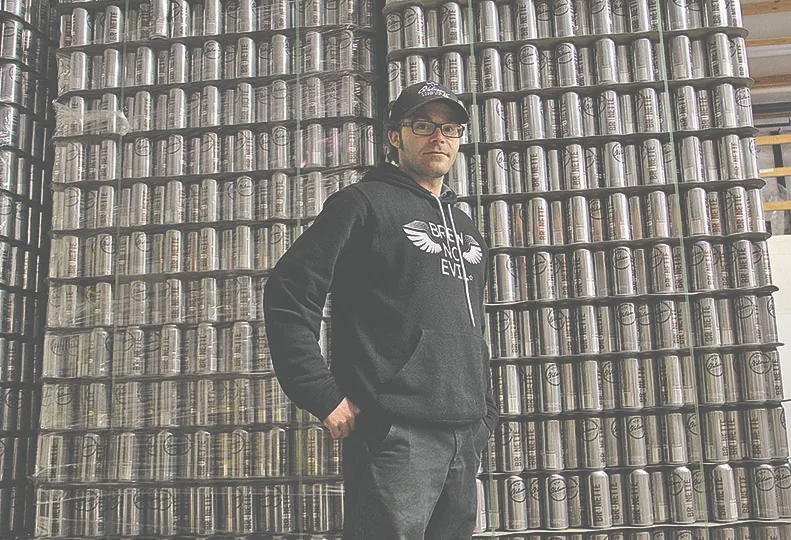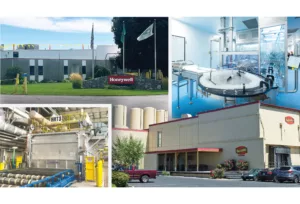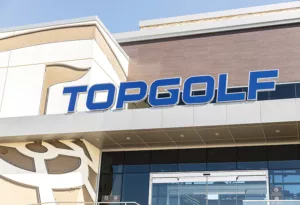Brewing no evil on the West Plains
-

Airway Heights brewery Orlison Brewing Co. has more than doubled its barrel output in the last year, says Bernie Düenwald, company co-owner, president, and brew master. Operations manager and brewer Mark Borland says he estimates the brewery will have sold about 1,500 barrels by the end of the year.
The rise in sales, Borland says, is primarily the result of an increase in demand brought on by a rebranding strategy the company launched earlier this year.
“Since we did our rebranding, we’ve gotten our name out there quite a bit more and demand has gone way up,” Borland says.
The brewery operates out of about 3,600 square feet of space at 12921 W. 17th in Airway Heights. The business, which opened in 2009, was known as Golden Hills Brewing Co. until last June and still operates under that corporate entity, with Orlison as a registered trade name. The name change, Borland says, was part of the rebranding.
“We did some market research on how to get our name out there,” he says. “It just didn’t have the right feel from a marketing standpoint, so we changed it.”
The name Orlison, he says, comes from a mash-up of majority co-owners Jason Miller and Orlin Reinbold’s first names. Reinbold was one of the company’s original investors, and about a year ago, he and Miller, also an investor, began putting more capital into the company and became co-owners.
The brewery has four full-time employees, Borland says, and three outside sales representatives. It’s also stop No. 5 on the Inland NW Ale Trail, a craft brewery tour here. The brewery’s tasting room is open Monday to Friday from 3:30 p.m. to 5:30 p.m., and Saturday by appointment. Orlison beer is available at stores and bars here, as well as around Washington state. Its website, www.orlisonbrewing.com, has a full list of locations.
The signature aspects of Orlison are that it brews only lager beers and that it uses cans instead of bottles. Düenwald says that when he decided to start the brewery, he went with a lager because it was underrepresented in the microbrewery market.
“There were so many good ale brewers in the Northwest already,” he says. “To be a productive brewer, you have to find a niche. There are very few craft brewers that focus on lagers. You also have to think, what down the road has potential to have substantial volume?”
Borland, who has been with the company since it launched in 2009, says many microbrewers stick to ales because they’re faster to produce, and thereby easier to profit on. Lager beers, Borland and Düenwald both say, have a big malt character with a crisp finish.
The differences between ales and lagers, Borland says, come mainly during the fermentation process.
“On the brewing side, when cooking, it’s basically the same,” he says. “The main differences come on the fermentation side, and it’s the temperature and time.”
Borland says that lagers ferment at a much cooler temperature, which causes them to break down more of the complex sugars that are present in the unfermented beer. Ales, he says, don’t break down as much of the sugar, and that’s why ales sometimes taste sweeter than lagers.
The lower temperature also means a lager takes longer to ferment, Borland says.
“The average ale fermentation takes 7 to 14 days,” he says. “Our lagers take 21 to 28 days.”
The brewery’s slogan, “Brew No Evil,” is their stated commitment to brewing the cleanest, clearest lagers they can.
“We filter all our beers,” Borland says. “It brings out more taste and makes them crisper.”
“Many people have the impression that lagers will be like mainstream beers,” Düenwald says. “But that’s not the case.”
Orlison recently also began canning its beers in 16-ounce cans, through a partnership with Northwest Canning, a Portland, Ore.-based mobile canning company. None of its beers are sold in bottles. The brewery decided to get into canning, Borland says, to help keep the beers fresh longer.
“Cans keep better,” Borland says. “Two things are bad for beer: oxygen and light. Cans don’t let in light like bottles, and cans can be filled to pretty much the top, which means less oxygen.”
Orlison produces and markets a total of six beers. Right now, Borland says, the brewery is selling four of its beers in cans: Brünette, Clem’s Gold, Lizzy’s Red, and Havanüther. By early spring, the rest will be available in cans also, Borland says. For now, the other two varieties, Ünderground and the India Pale Lager, are sold by the keg. Borland also says other microbreweries are starting to branch into cans.
“It’s kind of an up-and-coming thing,” he says. “More of the well-known breweries are starting to come out with cans.”
The brewery’s beers range in variety from gold, red and brown lagers, to a stout, a pilsner, and the India pale lager. The ingredients, mainly the hops, vary between each style. Different kinds of hops bring different notes to a beer, Borland says.
“Some strains of hops have citrus notes,” he says. “Some are more bitter. There’s some other stuff that changes, but it’s kind of the secret of brewing.”
Before founding the brewery, Düenwald worked in the grass seed industry, and says he worked with people who were in the brewing industry. He also brewed recreationally, he says.
“I’ve been in the industry before, and I raised malt and barley,” he says. “One thing led to another, and I started pilot brewing in 2006.”
Düenwald says he made the jump into opening his own brewery once he found he could make exactly what he wanted.
“Clem’s Gold was a beer I could envision, but I couldn’t find,” he says. “When I figured out I could make it, I started the brewery.”
Düenwald says once the brewery officially opened, it took about a year and a half to reach 600 barrels a year in sales.
“I was capital constrained,” he says. “About a year ago, one of our original investors brought in another, and they started putting capital into it. But it was basically a one-man show for three years.”
For the future, Borland says, the brewery is focusing on coming up with new varieties to add to its lineup of lagers.
“We’re just trying to come out with new products,” he says. “We’ve amped up production and added more fermentation. We’re brewing a lot more.”
Next spring, Borland says, the brewery is planning to release a new pilsner-style lager. Later next year, he says, it will be releasing a variation of its India pale lager, or IPL. Borland says the new version will be “like an IPL squared” and will have higher alcohol content and more hops than the company’s current IPL.
Related Articles
Related Products

_c.webp?t=1763626051)
_web.webp?t=1764835652)

